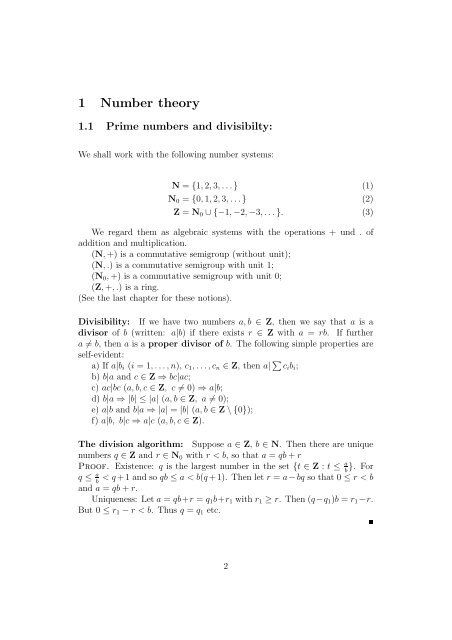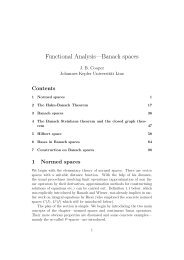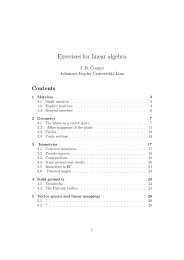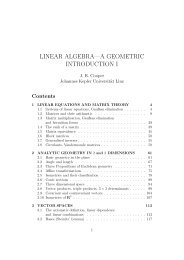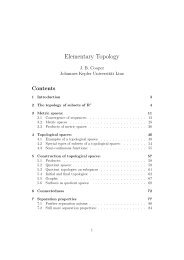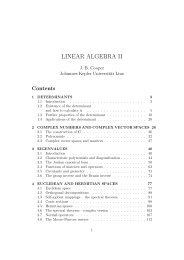Number theory, geometry and algebra - Dynamics-approx.jku.at
Number theory, geometry and algebra - Dynamics-approx.jku.at
Number theory, geometry and algebra - Dynamics-approx.jku.at
Create successful ePaper yourself
Turn your PDF publications into a flip-book with our unique Google optimized e-Paper software.
1 <strong>Number</strong> <strong>theory</strong><br />
1.1 Prime numbers <strong>and</strong> divisibilty:<br />
We shall work with the following number systems:<br />
N = {1,2,3,...} (1)<br />
N 0 = {0,1,2,3,...} (2)<br />
Z = N 0 ∪{−1,−2,−3,...}. (3)<br />
We regard them as <strong>algebra</strong>ic systems with the oper<strong>at</strong>ions + und . of<br />
addition <strong>and</strong> multiplic<strong>at</strong>ion.<br />
(N,+) is a commut<strong>at</strong>ive semigroup (without unit);<br />
(N,.) is a commut<strong>at</strong>ive semigroup with unit 1;<br />
(N 0 ,+) is a commut<strong>at</strong>ive semigroup with unit 0;<br />
(Z,+,.) is a ring.<br />
(See the last chapter for these notions).<br />
Divisibility: If we have two numbers a,b ∈ Z, then we say th<strong>at</strong> a is a<br />
divisor of b (written: a|b) if there exists r ∈ Z with a = rb. If further<br />
a ≠ b, then a is a proper divisor of b. The following simple properties are<br />
self-evident:<br />
a) If a|b i (i = 1,...,n), c 1 ,...,c n ∈ Z, then a| ∑ c i b i ;<br />
b) b|a <strong>and</strong> c ∈ Z ⇒ bc|ac;<br />
c) ac|bc (a,b,c ∈ Z, c ≠ 0) ⇒ a|b;<br />
d) b|a ⇒ |b| ≤ |a| (a,b ∈ Z, a ≠ 0);<br />
e) a|b <strong>and</strong> b|a ⇒ |a| = |b| (a,b ∈ Z\{0});<br />
f) a|b, b|c ⇒ a|c (a,b,c ∈ Z).<br />
The division algorithm: Suppose a ∈ Z, b ∈ N. Then there are unique<br />
numbers q ∈ Z <strong>and</strong> r ∈ N 0 with r < b, so th<strong>at</strong> a = qb+r<br />
Proof. Existence: q is the largest number in the set {t ∈ Z : t ≤ a }. For<br />
b<br />
q ≤ a < q+1 <strong>and</strong> so qb ≤ a < b(q+1). Then let r = a−bq so th<strong>at</strong> 0 ≤ r < b<br />
b<br />
<strong>and</strong> a = qb+r.<br />
Uniqueness: Let a = qb+r = q 1 b+r 1 with r 1 ≥ r. Then (q−q 1 )b = r 1 −r.<br />
But 0 ≤ r 1 −r < b. Thus q = q 1 etc.<br />
2


